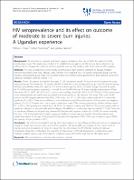| dc.contributor.author | Chalya, L Phillipo | |
| dc.contributor.author | Ssentongo, Robert | |
| dc.contributor.author | Kakande, Ignatius | |
| dc.date.accessioned | 2021-04-19T15:03:36Z | |
| dc.date.available | 2021-04-19T15:03:36Z | |
| dc.date.issued | 2011-06-09 | |
| dc.identifier.citation | Chalya, P.L., Ssentongo, R. and Kakande, I., 2011. HIV seroprevalence and its effect on outcome of moderate to severe burn injuries: A Ugandan experience. Journal of trauma management & outcomes, 5(1), pp.1-7. | en_US |
| dc.identifier.issn | 1752-2897 | |
| dc.identifier.uri | http://hdl.handle.net/20.500.12280/2671 | |
| dc.description.abstract | Background: HIV infection in a patient with burn injuries complicates the care of both the patient and the treating burn team. This study was conducted to establish the prevalence of HIV among burn patients in our setting and to compare the outcome of these patients who are HIV positive with those who are HIV negative.
Methods: This was a prospective cohort study involving burn injury patients admitted to Mulago Hospital between November 2005 and February 2006. Patients were stratified into HIV positive (exposed) group and HIV negative (unexposed) group. Data was collected using a pre-tested coded questionnaire and analyzed using SPSS statistical computer software version 11.5.
Results: Of the 130 patients included in the study, 17 (13.1%) patients tested HIV positive and this formed the study (exposed) group. The remaining 113 patients (86.9%) formed the control (unexposed) group. In the HIV positive group, females outnumbered males by a ratio of 1.4:1 and the mean age was 28.4 ± 21.5 years (range 3 months-34 years). 64.7% of HIV positive patients reported to have risk factors for HIV infection. Of these, multiple sexual partners [Odds Ratio 8.44, 95% C.I. (3.87-143.23), P = 0.011] and alcoholism [Odds Ratio 8.34, 95% C.I. (5.76-17.82), P = 0.002] were found to be independently and significantly associated with increased risk to HIV infection. The mean CD4 count for HIV positive and HIV negative patients were 394 ± 328 cells/μL and 912 ± 234 cells/μL respectively which is statistically significant (P = 0.001). There was no difference in the bacteria cultured from the wounds of HIV positive and negative patients (P = 0.322). Patients with clinical signs of sepsis had lower CD4+ counts compared to patients without sepsis (P < 0.001). ). Skin grafting was carried out in 35.3% of HIV negative patients and 29.4% of HIV positive patients with no significant difference in skin graft take and the degree of healed burn on discharge was the same (P = 0.324). There was no significant difference in hospital stay between HIV positive and negative patients (P = 0.674). The overall mortality rate was 11.5%. Using multivariate logistic regression analysis, mortality rate was found to be independently and significantly related to the age of the patient, HIV positive with stigmata of AIDS, CD4 count, inhalation injury, %TBSA and severity of burn (p-value < 0.001).
Conclusion: HIV infection is prevalent among burn injury patients in our setting and thus presents an occupational hazard to health care workers who care for these patients. All burn health care workers in this region need to practice universal precautions in order to reduce the risk of exposure to HIV infection and post-exposure prophylaxis should be emphasized. The outcome of burn injury in HIV infected patients is dependent upon multiple variables such as age of the patient, inhalation injury and %TBSA and not the HIV status alone. | en_US |
| dc.language.iso | en | en_US |
| dc.publisher | Springer Nature | en_US |
| dc.relation.ispartofseries | Journal of trauma management & outcomes;5(1) | |
| dc.subject | HIV Seroprevalence | en_US |
| dc.subject | Outcome | en_US |
| dc.subject | Burn Injuries | en_US |
| dc.subject | Uganda | en_US |
| dc.title | HIV seroprevalence and its effect on outcome of moderate to severe burn injuries: A Ugandan experience | en_US |
| dc.type | Article | en_US |


